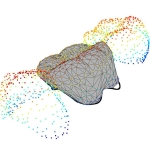MC-Net: Mesh Completion for Dental Scans

Abstract — Dental centers need to design hundreds of dental crowns per year using computer assisted design (CAD) software. Typically, technicians manually modify a template shape to create crowns. That process requires a lot of time and experience to be done correctly, which leads to great variability in quality. In recent years, many deep
learning methods have been proposed to do point cloud completion by predicting only the missing region. Although these methods are potentially applicable to the task of dental crown design, most of them fail to generate smooth point clouds, which is critical for surface reconstruction. In this paper, we propose an end-to-end approach called MCNet for automatic mesh completion of dental scans. Using an input point cloud sampled at multiple resolutions and a template shape for the type of tooth to generate, MC-Net extracts features to guide a mesh deformation. The mesh generation follows a coarse-to fine strategy and uses a mesh-related loss function to make the procedure stable. Our model can generate visually correct and accurate surfaces of the missing regions.
Our dental AI project described in depth by our team of researchers and engineers. In this publication, you can learn more about the design and generation of perfect dental crowns using artificial intelligence and machine learning.
In dental centers, technicians need to manually design hundreds of crowns per year. Crown generation implies designing an external surface that is visible once the crown is installed on the tooth preparation. That design is challenging even with today’s computer assisted design (CAD) software. The technician must design a tooth shape with a complex morphology and patient-specific characteristics. Usually, the dentist starts by making a preparation with the damaged tooth. The preparation serves as a foundation on which the dental crown will be installed. Secondly, the dentist scans the prepared tooth and the surrounding teeth with an intra-oral scanner to get a 3D representation. Finally, the technician uses that surrounding information to design a patient-specific crown.
Olivier Lessard, Member, IEEE, François Guibault, Member, IEEE, Julia Keren and Farida Cheriet, Senior Member, IEEE
You may read the full publication here.


